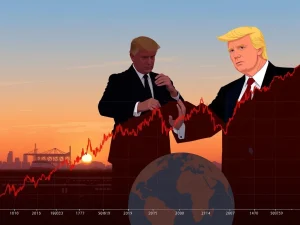Astounding Raoul Pal Crypto Prediction: 4 Billion Users by 2030 and a $100 Trillion Market Cap

The cryptocurrency world often buzzes with bold forecasts. Recently, financial expert Raoul Pal made an astounding Raoul Pal crypto prediction. He foresees a massive expansion in digital asset adoption. Pal, the CEO of Real Vision, projects crypto users will reach 4 billion by 2030. This remarkable figure suggests a significant shift in global finance. Furthermore, he believes the total crypto market capitalization could hit an unprecedented $100 trillion within the next decade. These predictions highlight a profoundly optimistic outlook for the future of crypto users.
Understanding Raoul Pal’s Crypto Adoption Forecast
Raoul Pal, a renowned figure in global macro investing, shared compelling data. He compared the adoption rate of crypto users to that of internet users. This comparison began after each innovation reached 5 million users. Pal utilized the number of crypto wallets to gauge user growth. Similarly, he used IP addresses to track internet adoption. His analysis paints a vivid picture of rapid expansion. This methodology provides a historical context for his bold projections.
According to Pal’s findings, the total crypto user base has seen an extraordinary surge. It grew by 137% annually over nine years. By the end of 2024, it reached an estimated 659 million users. For comparison, the internet’s user base grew at a 76% annual rate. It hit 187 million users by the end of 2000. Therefore, crypto’s current growth trajectory significantly outpaces the internet’s early stages. Pal’s crypto adoption forecast suggests a moderate 43% growth next year. This would lead to 1 billion crypto users by 2030. This figure represents one-eighth of the global population. Such widespread adoption would fundamentally transform financial systems worldwide.
The Path to a $100 Trillion Crypto Market Cap Growth
Pal’s bullish outlook extends beyond user numbers. He predicts the total crypto market capitalization could cross the $100 trillion mark. This could happen within the next decade. Specifically, he suggests this milestone could be achieved as early as 2032. Several key factors, according to Pal, will drive this colossal crypto market cap growth. These primary catalysts are currency debasement and widespread adoption.
Currency debasement refers to the reduction in the purchasing power of fiat currencies. Central banks often print more money, which can lead to inflation. Consequently, investors seek alternative stores of value. Digital assets like Bitcoin and other cryptocurrencies offer a hedge against this debasement. Pal asserts, “Debasement explains 90% of price action.” This indicates a strong correlation between traditional currency devaluation and crypto’s rise. Furthermore, adoption explains the outperformance of crypto against this debasement. As more individuals and institutions embrace cryptocurrencies, demand increases. This increased demand, combined with limited supply for many assets, naturally pushes market capitalization higher. This dual mechanism creates a powerful upward force for the entire crypto ecosystem.
Analyzing the Future of Crypto Users: Wallets vs. Real People
While Pal’s predictions are compelling, some community members express skepticism. On Pal’s X post, several users questioned the reliability of wallet counts. One X user argued that wallets are not a definitive measure of unique users. For instance, a crypto project founder could create numerous wallets. They might spread coins to artificially inflate community size. Another user highlighted personal practices. They create a new wallet every six months. This behavior could lead to an overestimation of actual user numbers over time.
However, Pal addressed these concerns directly. He countered by pointing out that individuals often have multiple IP addresses. This analogy suggests that measuring unique users in the digital realm is inherently complex. Despite this debate, independent data offers further insights into the future of crypto users. According to Triple-A, a B2B digital currency platform, over 560 million crypto users existed by the end of 2024. Meanwhile, an October 2024 report from Andreessen Horowitz’s crypto division provided a more conservative estimate. It indicated roughly 30 million to 60 million real crypto users monthly. These varying figures underscore the challenge of precise user measurement in a rapidly evolving space.
Driving Factors for Digital Asset Expansion
Beyond debasement and adoption, several other macro trends contribute to the projected digital asset expansion. Technological advancements continue to improve blockchain scalability and user experience. This makes cryptocurrencies more accessible to a broader audience. Furthermore, regulatory clarity is slowly emerging in various jurisdictions. This provides a more stable environment for institutional investment. Large financial institutions are increasingly exploring crypto products and services. Their involvement lends significant credibility and capital to the market. Moreover, the growing integration of blockchain technology into everyday applications, such as supply chain management and decentralized finance (DeFi), drives practical utility. This utility moves cryptocurrencies beyond speculative assets.
The younger generations, often referred to as digital natives, show a higher propensity for crypto adoption. They are comfortable with digital currencies and decentralized systems. This demographic shift provides a long-term tailwind for user growth. Emerging markets, facing unstable local currencies and limited access to traditional banking, also find value in crypto. They use it for remittances, savings, and payments. Consequently, global economic shifts and demographic trends further bolster the case for substantial digital asset expansion. This multifaceted growth indicates a profound transformation of the global financial landscape.
Potential Roadblocks and Nuances in the Raoul Pal Crypto Prediction
While Raoul Pal’s vision is optimistic, several potential roadblocks exist. Regulatory crackdowns in major economies could slow adoption. Technical challenges, such as network congestion or security vulnerabilities, might deter new users. Furthermore, significant market volatility could shake investor confidence. Geopolitical events could also impact the global economic climate, affecting investment in riskier assets. These factors, though not negating the overall trend, could influence the pace and trajectory of growth. The path to 4 billion users and a $100 trillion market cap is unlikely to be linear. It will likely feature periods of consolidation and even retraction.
The definition of a ‘crypto user’ itself remains fluid. Is it someone holding a small amount of crypto, or an active participant in the ecosystem? This distinction impacts user count accuracy. Despite these complexities, the underlying trends of technological innovation and increasing financial disintermediation remain strong. Pal’s analysis provides a high-level framework. However, the exact timing and magnitude of these milestones will depend on numerous evolving variables. Nevertheless, his Raoul Pal crypto prediction serves as a powerful indicator of the industry’s long-term potential.
Conclusion: A Glimpse into the Future of Crypto
Raoul Pal’s bold forecasts paint a picture of an astonishing future for cryptocurrencies. His projection of 4 billion users by 2030 and a $100 trillion market capitalization by 2032 is truly remarkable. This vision rests on the compelling comparison to internet adoption rates. It also highlights the powerful forces of currency debasement and widespread adoption. While community discussions reveal nuances in user measurement, the overall trajectory points towards significant growth. The continuous digital asset expansion, fueled by technological progress, institutional interest, and demographic shifts, underpins this optimistic outlook. Ultimately, the future of crypto users appears poised for unprecedented growth, transforming global finance forever.








